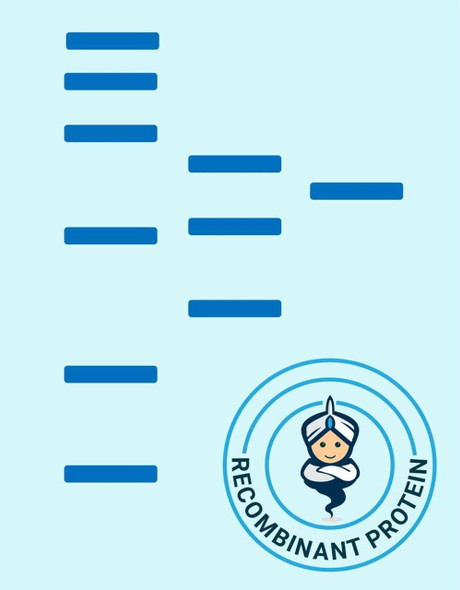Description
| Product Name: | Human TGF beta 3 Recombinant Protein (N-His) (active) |
| Product Code: | RPES6506 |
| Size: | 20µg |
| Species: | Human |
| Expression Host: | E.coli |
| Synonyms: | ARVD, ARVD1, LDS5, RNHF, TGFB3, TGF-B3 |
| Mol Mass: | 48.16 kDa |
| Tag: | N-His |
| Purity: | > 98 % as determined by reducing SDS-PAGE. |
| Endotoxin Level: | < 0.1 EU per μg of the protein as determined by the LAL method. |
| Bio Activity: | Measure by its ability to inhibit IL-4-induce proliferation in HT-2 cells. The ED50 for this effect is < 50 pg/mL. The specific activity of recombinant human TGF beta 3 is > 2 x 107IU/mg. |
| Sequence: | MKMHLQRALVVLALLNFATVSLSLSTCTTLDFGHIKKKRVEAIRGQILSKLRLTSPPEPTVMTHVPYQVLALYNSTRELLEEMHGEREEGCTQENTESEYYAKEIHKFDMIQGLAEHNELAVCPKGITSKVFRFNVSSVEKNRTNLFRAEFRVLRVPNPSSKRNEQRIELFQILRPDEHIAKQRYIGGKNLPTRGTAEWLSFDVTDTVREWLLRRESNLGLEISIHCPCHTFQPNGDILENIHEVMEIKFKGVDNEDDHGRGDLGRLKKQKDHHNPHLILMMIPPHRLDNPGQGGQRKKRALDTNYCFRNLEENCCVRPLYIDFRQDLGWKWVHEPKGYYANFCSGPCPYLRSADTTHSTVLGLYNTLNPEASASPCCVPQDLEPLTILYYVGRTPKVEQLSNMVVKSCKCS |
| Accession: | P10600 |
| Storage: | Generally, lyophilized proteins are stable for up to 12 months when stored at -20 to -80°C. Reconstituted protein solution can be stored at 4-8°C for 2-7 days. Aliquots of reconstituted samples are stable at < -20°C for 3 months. |
| Shipping: | This product is provided as lyophilized powder which is shipped with ice packs. |
| Formulation: | Lyophilized from a solution containing 20 mM sodium citrate, 0.2 M NaCl, pH 3.5. Normally 5 % - 8 % trehalose, mannitol and 0.01% Tween80 are added as protectants before lyophilization. Please refer to the specific buffer information in the printe |
| Reconstitution: | Please refer to the printed manual for detailed information. |
| Background: | TGF¬-beta 3 (transforming growth factor-beta 3) is a member of a TGF¬-beta superfamily subgroup that is defined by their structural and functional similarities. TGF-beta 3 and its closely related proteins, TGF-beta 1 and ¬ beta 2, act as cellular switches to regulate immune function, cell proliferation, and epithelial-¬mesenchymal transition. The non-redundant biological effects of TGF-¬ beta 3 include involvement in palatogenesis, chondrogenesis, and pulmonary development. Rat TGF¬-beta 3 cDNA encodes a 412 amino acid (aa) precursor that contains a 23 aa signal peptide and a 389 aa proprotein. TGF-beta 3 is secreted as a latent complex. This latent form of TGF-beta 3 is activated by integrins, thrombospondin-1, plasmin, and matrix metalloproteases. It can also be activated by extreme pH and reactive oxygen species. TGF-beta 3 binds with high affinity to TGF-beta RII, a type II serine/threonine kinase receptor. This receptor then phosphorylates and activates type I serine/threonine kinase receptors, TGF-¬ beta RI or ALK-¬1, to modulate transcription through Smad phosphorylation. The divergent biological effects exerted by individual TGF-beta isoforms is dependent upon the recruitment of co-receptors (TGF-¬ beta RIII and endoglin) and the subsequent initiation of Smad--dependent or -independent signaling pathways. |






